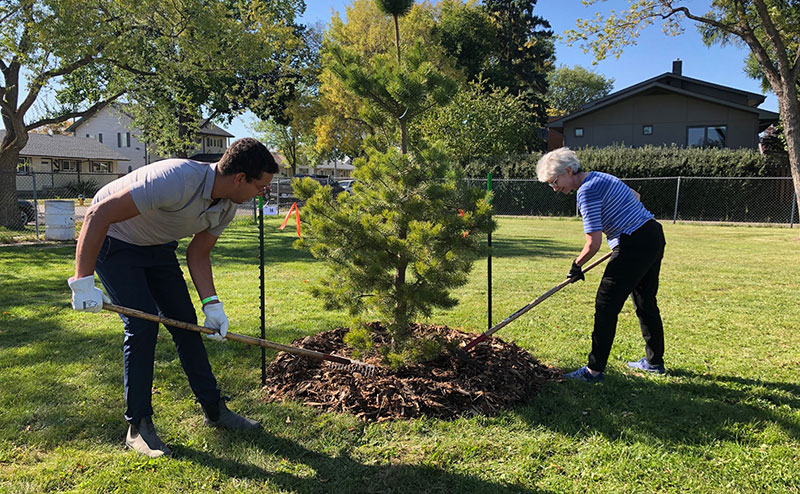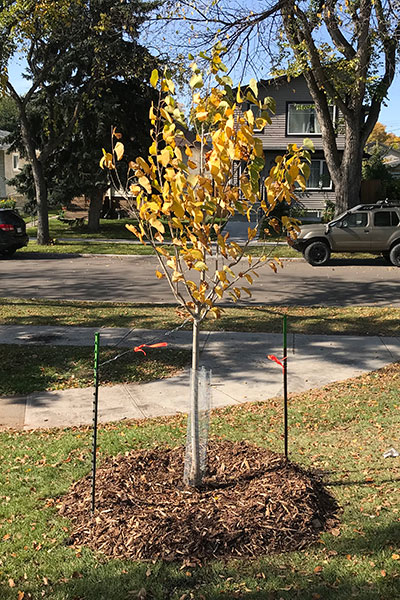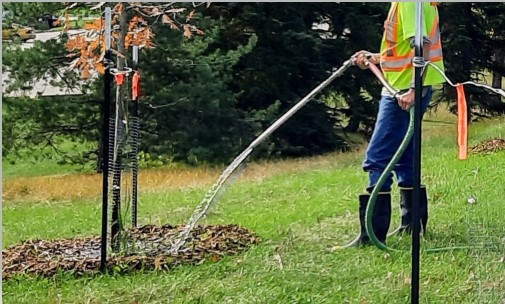
The Community Standards Bylaw 14600 regulates trees on City boulevards, overhanging trees on sidewalks, noxious weeds, long grass and landscaping requirements.
Edmontonians benefit from trees growing on both public and private property. Trees purify the air that we breathe, cool our neighbourhoods, improve water quality, reduce flooding, combat climate change through carbon sequestration, and promote overall well-being and positive mental health.
Private landowners play an essential role in enhancing the livability and quality of life in their neighbourhoods through the planting, maintenance and preservation of trees on private property. By learning and implementing proper tree care techniques, you can help to maximize the lifelong benefits that your trees provide.
How to Plant Trees
Properly planting a tree species that is suitable for your yard helps to set your tree up for success. Key considerations when selecting a tree species are the hours of direct sunlight it will receive, if there is enough room above and below ground for the tree’s mature size, how much soil moisture it requires, and climate conditions. Edmonton has a plant hardiness zone of 4a. Select a species that can handle Edmonton’s cold snaps and heat waves, including considerations for how your yard might be uniquely impacted from heat exposure or Edmonton’s chilling NW winter winds.
If possible, select a tree species that is less commonly planted, which will help to make your yard unique and will improve the diversity of Edmonton’s urban forest.
Don’t worry if you are feeling overwhelmed. Seeking advice from a local nursery can help to ensure that you are selecting the right tree species.
Once you’ve selected the perfect tree, it’s time to pick up your shovel and follow the planting tips listed below.
- In Edmonton, late spring and early fall are ideal times to plant. Planting can be done during the summer; however, it should be avoided during heat-waves.
- Contact Utility Safety Partners to ensure that there are no conflicting underground utilities near your desired planting location.
- Handle with care. Always lift the tree by the rootball.
- Remove all the packaging from the tree. If the root ball is contained within a metal basket and/or burlap, only remove the top portion of the packaging to expose the root flare. A root flare, also called tree flare, is the section of the trunk that broadens to join with the upper main roots - roots that are at least as thick as a pencil. The remaining packaging should be removed once the tree has been placed in the hole - removing as much of the burlap and wiring as possible without causing the root ball to start to fall apart.
- Remove excess soil from the top of the root ball to reveal the root flare, which should be located slightly above the ground after planting.
- Dig a hole that is approximately 2-3 times as wide as the root ball, with a depth equal to the height of the remaining root ball.
- Check for encircling roots. Reorient or cut roots that are growing in a circular pattern to prevent such roots from girdling the tree in the future.
- Backfill the hole with good soil. You can generally use the soil that you dug out of the hole, unless it is primarily clay. As you add soil to the hole, gently tamp it with your foot to secure the tree in place and to remove large air pockets.
- Top with a 5-7cm deep mulch ring to help with moisture retention and to improve soil quality. This mulch will also help to protect the tree’s roots from extreme weather conditions, which are becoming more common in Edmonton. Keep the mulch at least 5cm away from the tree trunk to prevent moisture from building up against the trunk which can cause decay. Mulch should be reapplied as it breaks down as mature trees benefit from mulch too. Ensure that the mulch isn’t deeper than 10 cm as too much mulch may prevent oxygen from entering the soil, which roots need to survive.
- Immediately water in the newly planted tree. See watering tips below.
For more information, reference the Tree Planting video that corresponds to the root ball packaging of your tree.
How to Water Trees
It is crucial for newly planted trees to be watered regularly for the first 3 growing seasons. Following this period, trees will benefit from watering when there is little rain or signs of drought. Use these watering tips for your privately-owned trees.
- Water your tree in the early morning or evening.
- Trees can drown! Confirm that the soil is dry prior to watering. Put your finger into the soil - if it is moist to the touch, your tree may not need watering just yet.
- Water between the base of the tree and the tree's drip line, which is the imaginary line extending from the outermost branch tips straight down to the ground.
- Water slowly and deeply to reach the roots responsible for gathering water. This is best achieved by applying a slow trickle of water, which may take a few hours for larger-sized trees. Slow watering is especially important in Edmonton as clay loam soil (soil that consists mostly of clay) is common. Due to the small particle size of clay, water absorbs very slowly into the soil and will run off if applied too quickly.
- During drought conditions, the soil may first repel the water. Water lightly several times on the first day until the soil will accept the water.
- Avoid getting water directly on the tree as it increases the likelihood of tree pathogens occurring.
- Apply wood mulch to help to keep the roots cool and moist.
- Water your trees well in early spring after the ground thaws and in the fall right before the ground freezes to prepare for winter.
The City waters newly-planted and transplanted City-owned trees regularly for approximately the first 3 years. If your new boulevard tree needs attention, please contact 311.
How to Prune Trees
Pruning promotes long-term health and structure and helps to eliminate potential hazards. Property owners have a responsibility to maintain their trees to prevent damage to nearby public property or infrastructure, or obstructions to road right-of-ways.
For more information on Community Standards Bylaw 14600 maintenance requirements, see Tree and Plant Complaints.
Use these pruning tips for your privately-owned trees:
- Keep your pruning tools sharp and clean.
- If your tree requires a lot of pruning, spread it out over several years. The percentage of live foliage that may be removed in a given season will vary from tree-to-tree based on factors such as tree health, species and age.
Remove all diseased, dead and dying limbs and crossing branches.
For more pruning information, including how to make proper pruning cuts, visit Trees Are Good.
Is your tree next a power line? Please contact EPCOR to arrange for pruning.
For those who require assistance pruning trees, the City recommends using a certified ISA Arborist.
Pruning Elm Trees
The Community Standards Bylaw regulates the removal, pruning, transportation, storage and sale of elm trees in the city to prevent the spread of Dutch elm disease. Elm tree pruning is only permitted between October 1 and March 31.
If there is an immediate concern requiring elm tree pruning outside the regulated season, please contact Pest Management to be considered for an exemption permit.
All elm wood, mulch and chips must be disposed of immediately by burning them or bringing them to the Edmonton Waste Management Centre at 250 Aurum Road. When you arrive, tell the scale operator that you have elm wood so it can be handled appropriately. Disposal fees are waived for residents.
- Do not combine elm wood with food scraps or other collected waste
Do not bring elm wood to an Eco Station
Do not stack, pile or save elm wood
Controlling Pests and Disease
Some insects and fungi are good for trees while others are not. Knowing which tree pests and diseases your trees are susceptible to can help you to take preventative measures to keep your trees healthy. Learn more about tree pests and disease.
Some key pests and diseases to be aware of in the Edmonton area include:
- Emerald Ash Borer, not currently in Edmonton
- Dutch Elm Disease
- Black Knot
Are you worried about your tree and need advice? Contact 311.
Contact Us
311 Contact Centre
Phone 311 | Outside Edmonton and Video Relay Service (VRS): 780-442-5311 | TTY 711



